
Recovery for Cycling and Why Most Don’t Get It
Ask a cyclist how to get faster and most of them will talk about training harder, the latest bike/wheels/skinsuit but vary rarely will they talk about recovery after cycling.
My observation in bike riding over 5 decades is that in General, Cyclists has been a very conservative group in adopting new trends and have often followed other groups such as Triathletes when it comes to adopting new ideas. Examples of this are bike frame evolution to Titanium, Carbon, aero shaped carbon, aerobars, helmets, wheels, clothing etc.
So it goes for the topic of recovery. The truth is that amateur riders have never had great role models or best practises from the pro Peleton who over the decades relied on “Special” methods of recovery.
The undeniable truth is that training makes you worse and recovery makes you better and its only when you recover do the gains lock themselves in.
Your three best bets at a super recovery technique are sleeping, eating right, and a well-designed training plan. Whether you are an amateur or a pro, sleep and sleep quality for a good amount of time, eating healthier, and improving the quality of your training, along with racing will make recovery easier to at least 80%. The remaining 20% wouldn’t matter if you do not take the aforementioned steps seriously. You may like to refer to these as marginal gains, so let’s take a look –
Sleeping
This is your number one way to recover and anything you do from a recovery point of view should influence sleep improvements. According to research done, the more sleep you get, the better your chance at recovery, which means you will perform better. Job stress, family, and life in general often leads to people not getting enough sleep. Athletes should make efforts to get, at least 8 hours of sleep or more. Its not just the quantity of sleep, the quality is also import – the balance between REM/Deep sleep at about 2 hours each and keeping the levels of light sleep at around no more than 50% of the total. This will allow all the mental and physical systems to reset, repair, heal and grow.
Sleep hygiene is an important consideration, a cool, dark room with sound proofing if possible. An eye mask can help to block out the light and ear plugs if sound proofing is not possible. Staying away from screens in all their forms two hours before bed will make sleeping easier.
Powernaps also play a role and 20 to 30 mins can make a big difference to your daily recovery. get as much as 20 to 60minutes nap after riding in the afternoon.
Being in sync with sunrise and sunset is a natural way to get you’re your body into healthy sleeping habits. Balancing your professional life with training to ace your athletic performance is key. Being short on sleep certainly reduces the performance of every athlete. If you’d have intense training after a long day of work, get to bed almost immediately. Before worrying so much about training, check how well you sleep and a good practice is to reduce or delay training load to manage the overall recovery from the stress load.
It’s a good idea to track your sleep with devices like Fitbit, Garmin, or any similar devices, to monitor quantity and quality of sleep. Prioritise recovery over training, this may mean delaying a training session by 4 to 8 hours or calling a rest day on yourself.
Nutrition
This is a big topic in itself, we will keep it brief for this post. ‘
When you are training and racing every day and every week, you need to make sure that your nutrition is at its best. From what you take before a workout, to what you take after the workout, they all have their effects on how your body deals with training and racing. To reduce muscle inflammation, go for an anti-inflammatory diet, which means zero gluten and no dairy. More so, athletes should take at least one ounce of fluid per one pound of body weight daily.
Post training, 30 to 45 minutes after a workout, your glycogen window is open, at this point, you are required to take in a recovery snack, which is 3:1 to 5:1 CHO to protein. Chicken and rice with veggies are a perfect recovery meal. If you are not near a kitchen, then go for a protein smoothie, with the aforementioned ratio.
Active recovery
If you can find the time, take an active recovery ride, restricting yourself to zone 1. This will help your muscles receive oxygenated blood, making them recover faster. These rides will only be beneficial when you are getting enough sleep, if you are not, these rides will do nothing. When you are done with these rides, always use a foam roller to get out your hamstrings, calves, quads, and glues, getting an Epsom salt ice bath will do you so much good. Also, try out compression boots or tights.
Next Level Recovery
Sports massage from a good sports masseuse in a once or twice a month frequency is a great way of restoring range of movement (ROM) from repetitive sports such as cycling. Schedule this for a recovery week as you are quite likely to be worse before you are better due to the breaking down of scar tissue and the lengthening of muscles. I would put percussion guns in this category also as an ROM restoration tool.
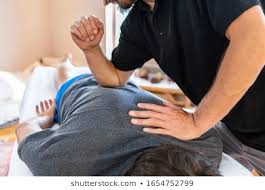
Foam rolling and stretching are quick and convenient ways of regular restoration of ROM. If time permits adding Yoga to your routine will also be beneficial.
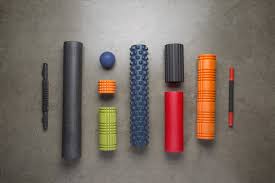
Getting a Whole-Body Cryotherapy (WBC) will help in reducing muscle inflammation. There is some research going on WBC, but at the moment, no conclusive data is proving how good WBC works. Contrast therapy (going from cold to hot and repeating.) can also have positive effects on recovery. However, this is something that you should try out if you can afford the time for it. It is also something that you can completely disregard as there is no definite answer.

Ice alone for recovery is a contentious topic, ice delays inflammation which is the first phase of healing, recovery and gains. Ice delays this process and may mitigate muscle growth. On the other hand, Ice for Trauma is a valid modality and will discuss this later in this blog.
Compression
Can Compression Recovery Enhance Your Performance?
Compression garments have helped athletes accelerate recovery and enhance performance for over 70 years. But the gold medal question is, do compression cycling recovery boots work?
Today there exists both Static compression and active compression known as Intermittent Pneumatic Compression.
Static forms of compression recovery have remained a fashion trend in the fitness industry. Whether you are at the gym or cycling through the city, spandex is everywhere. However static compression has limited effectiveness as its one directional.
Results of a recent study revealed that the higher levels of compression yielded higher levels in performance. (see our Blog on high compression and performance.)
Here’s a quick summary of the difference between static compression and IPC
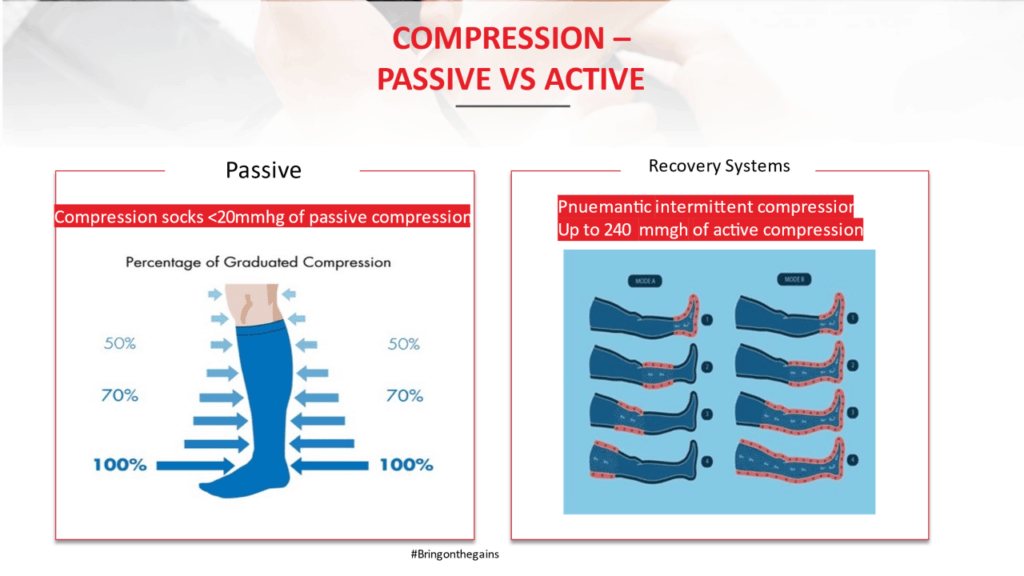
Benefits of IPC (Intermittent Pneumatic Compression)
The primary mechanism for the effectiveness of IPC is that it enhances circulatory and arterial blood flow via the intermittent inflation of Recovery System cuffs. Typically, intermittent compression is 10 x more powerful than compression garments, and it’s the milking action or squeeze and release that gives them a considerable edge over static compression garments. The removal of waste products may reduce injury risk and the phenomenon of delayed onset muscle soreness (DOMS).
IPC has been shown to be beneficial to 4 aspects of Athlete life – Warm up, recovery, rehab and travel. the warm-down activities of athletes.
Let’s take a look at each of these:
Warm-up
Eight minutes on an IPC cuff is equivalent to a 30-to-40-minute warm-up run/ride. (measured by muscle oxygen increase) This allows a warm-up at a lower metabolic cost and saves your energy and time, saving valuable energy to allow the athlete to hit the high notes of a given training session.
Recovery
Studies have shown that athletes who undergo IPC treatment have a lower heart rate and blood pressure than those who did not use IPC.
Higher pressure IPC treatments allowed athletes to maintain their performance after a higher volume of intense works outs.
Incorporating IPC into your post-workout will enable you to recover faster, which means athletes can train more often. Gains or improvements also lock in faster, given the faster recovery time to allow the magic of super-compensation or gains.
Boots are easy and convenient to use, taking less that 30 seconds to slip on and start the recovery process. Portability means recovery can happen anytime, anywhere – this is important as what is convenient and repeatable usually gets done and will make a difference.
Part of the recovery benefits are to the Parasympathetic System.
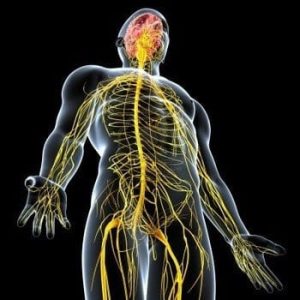
Stress is part of our lives and even more so for athletes with a high training load.
IPC has excellent benefits and a critical beneficial influence over the parasympathetic nervous system.
The parasympathetic nervous system is a part of the autonomic nervous system (our bodies version of autopilot) — the part of your brain that balances and manages and brings everything back homeostasis.
The parasympathetic is also known as “rest/digest”, which handles slowing things down and reallocating blood away from your muscles to vital organs so you can perform internal functions.
It slows down the heart and breathing while relaxing your muscles, which produces vasodilation. It usually results in cold hands and feet. We have talked a lot about this. Still, the thing to understand is that if you can create vasodilation and warm your hands and feet, you activate your parasympathetic handling.
So, these are not isolated things. They all work together. When you increase one, you increase all of this. So, it can have incredibly profound far-reaching influences and benefits on your health.
The first thing that we want to talk about is digestion. These functions – digestion, immune system, anabolism, and reproduction – are 100% controlled by the parasympathetic.
The sympathetic does not influence these, except that it can shut off the parasympathetic. So, to drive this forward, we need to induce parasympathetic activation.
Anabolism is the process of building things up. Catabolism is breaking down. Anabolism is building up (your body tries to do this all the time).
Forms of Anabolism:
• Growth
• Repair
• Healing
• Replacement of tissue
• Regeneration of tissue
IPC promotes the parasympathetic process. It slows down the heart and breathing. It relaxes muscles, and it produces vasodilation. It encourages waste elimination and accelerates the delivery of fresh nutrients for healing recovery and gains. Most people report that they fall asleep during treatment, and this is undoubtedly a significant parasympathetic benefit as anything that influences sleep and sleep quality is gold.

Rehab
At some stage an athlete will face the prospect of rehab from trauma. Where bruising or pain is present, adding ice packs will create ICT (Ice Compression Therapy) cuff will help control bruising and pain relief.
Ice should only be used during the trauma period where pain is present, beyond that, the IPC by itself is more appropriate as adding ice to a none trauma treatment will delay the onset of inflammation which is the first phase of healing, at this point IPC is great for accelerating the healing, recovery and gains.
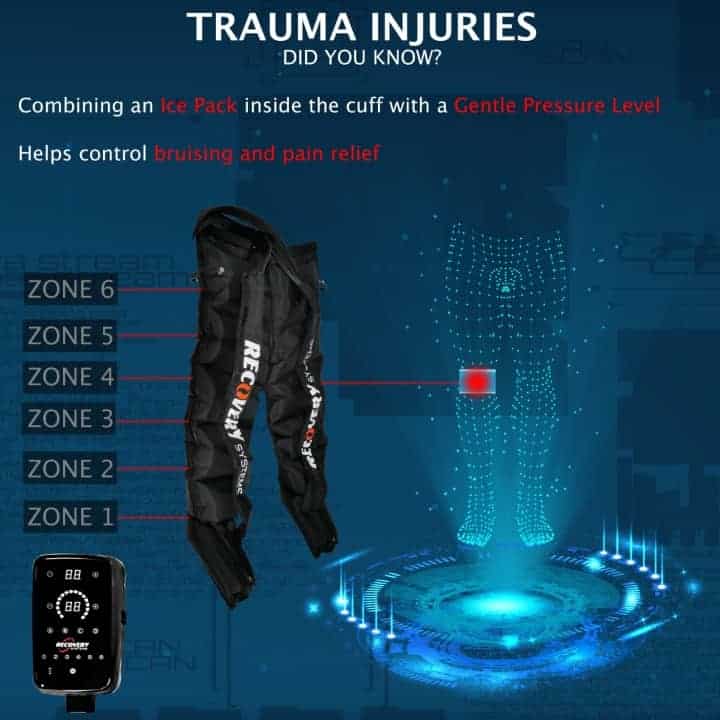
Travel
Travel is always fatiguing and particularly air travel where many passengers suffer from edema (swelling) due to the pressurised airline cabin. Regardless if you are traveling for work, leisure or a key race then Recovery Systems can be used on a plane to keep swelling at bay so you are ready for action at your destination.

Frequency and Measuring Recovery
Of all the methods we have discussed, its generally what is convenient and repeatable that gets done and contributes to sleep quantity and quality and of course gains. To effectively measure your recovery, just see how your body reacts the next day. If you are having a great ride, then you have a high-power production, and that means your recovery process was successful. If on day three or day four, you do not feel great, you need a rest day and you need it yesterday. Of course, full rest days will be a factor to see how well you have recovered. Another way you can measure recovery is by making use of the recovery score. The device used will measure your sleep, daily strain, and heart rate variability. The scores and how you feel on the bike after the rest days together will show you how far your recovery went.
Best wishes in your journey to be your best as you in building a repeatable routine with convenient tools to #warmupfaster #recoverfaster and #bringonthegains
